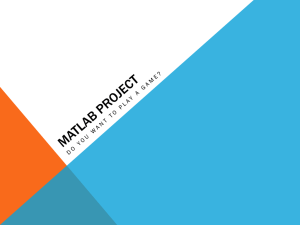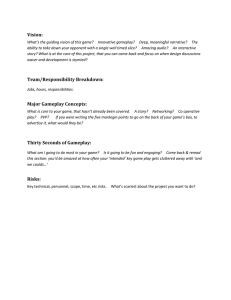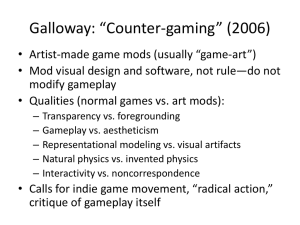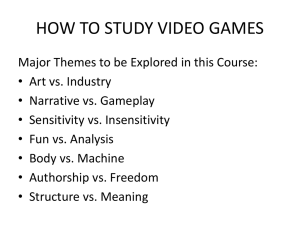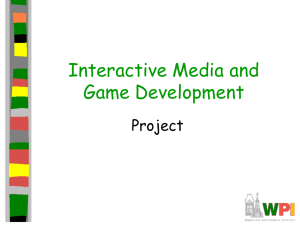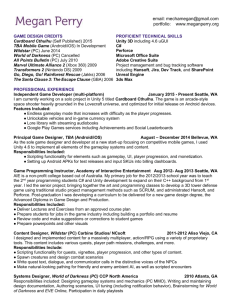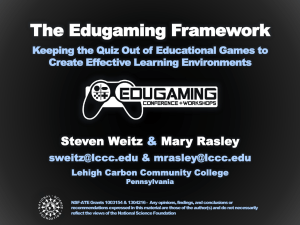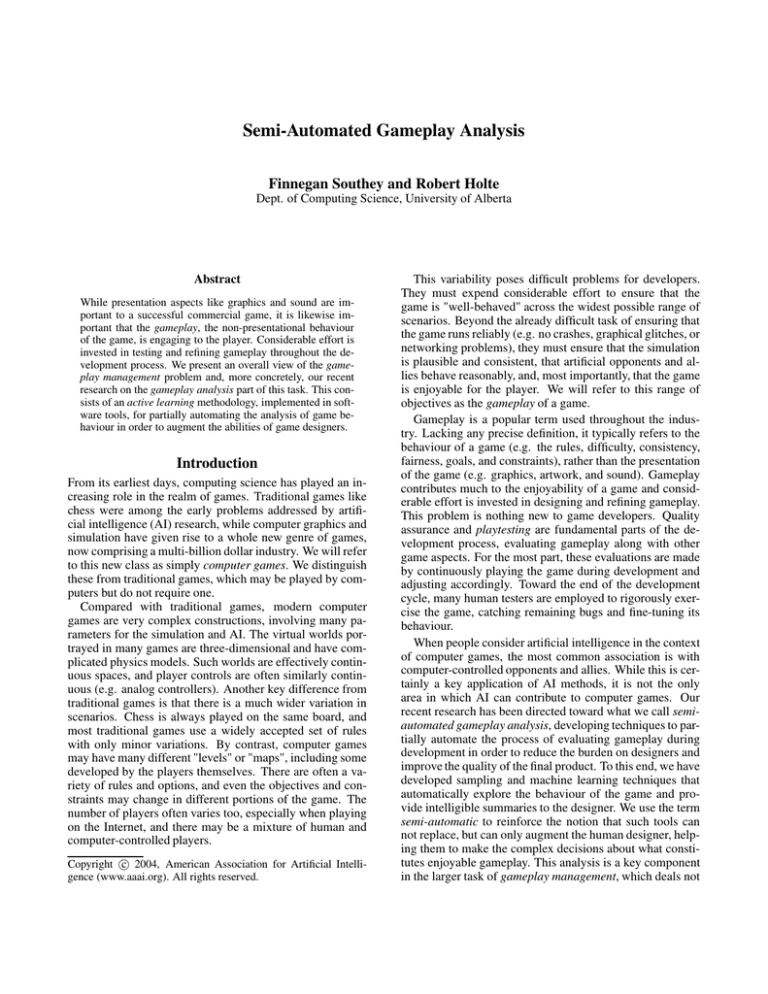
Semi-Automated Gameplay Analysis
Finnegan Southey and Robert Holte
Dept. of Computing Science, University of Alberta
Abstract
While presentation aspects like graphics and sound are important to a successful commercial game, it is likewise important that the gameplay, the non-presentational behaviour
of the game, is engaging to the player. Considerable effort is
invested in testing and refining gameplay throughout the development process. We present an overall view of the gameplay management problem and, more concretely, our recent
research on the gameplay analysis part of this task. This consists of an active learning methodology, implemented in software tools, for partially automating the analysis of game behaviour in order to augment the abilities of game designers.
Introduction
From its earliest days, computing science has played an increasing role in the realm of games. Traditional games like
chess were among the early problems addressed by artificial intelligence (AI) research, while computer graphics and
simulation have given rise to a whole new genre of games,
now comprising a multi-billion dollar industry. We will refer
to this new class as simply computer games. We distinguish
these from traditional games, which may be played by computers but do not require one.
Compared with traditional games, modern computer
games are very complex constructions, involving many parameters for the simulation and AI. The virtual worlds portrayed in many games are three-dimensional and have complicated physics models. Such worlds are effectively continuous spaces, and player controls are often similarly continuous (e.g. analog controllers). Another key difference from
traditional games is that there is a much wider variation in
scenarios. Chess is always played on the same board, and
most traditional games use a widely accepted set of rules
with only minor variations. By contrast, computer games
may have many different "levels" or "maps", including some
developed by the players themselves. There are often a variety of rules and options, and even the objectives and constraints may change in different portions of the game. The
number of players often varies too, especially when playing
on the Internet, and there may be a mixture of human and
computer-controlled players.
c 2004, American Association for Artificial IntelliCopyright gence (www.aaai.org). All rights reserved.
This variability poses difficult problems for developers.
They must expend considerable effort to ensure that the
game is "well-behaved" across the widest possible range of
scenarios. Beyond the already difficult task of ensuring that
the game runs reliably (e.g. no crashes, graphical glitches, or
networking problems), they must ensure that the simulation
is plausible and consistent, that artificial opponents and allies behave reasonably, and, most importantly, that the game
is enjoyable for the player. We will refer to this range of
objectives as the gameplay of a game.
Gameplay is a popular term used throughout the industry. Lacking any precise definition, it typically refers to the
behaviour of a game (e.g. the rules, difficulty, consistency,
fairness, goals, and constraints), rather than the presentation
of the game (e.g. graphics, artwork, and sound). Gameplay
contributes much to the enjoyability of a game and considerable effort is invested in designing and refining gameplay.
This problem is nothing new to game developers. Quality
assurance and playtesting are fundamental parts of the development process, evaluating gameplay along with other
game aspects. For the most part, these evaluations are made
by continuously playing the game during development and
adjusting accordingly. Toward the end of the development
cycle, many human testers are employed to rigorously exercise the game, catching remaining bugs and fine-tuning its
behaviour.
When people consider artificial intelligence in the context
of computer games, the most common association is with
computer-controlled opponents and allies. While this is certainly a key application of AI methods, it is not the only
area in which AI can contribute to computer games. Our
recent research has been directed toward what we call semiautomated gameplay analysis, developing techniques to partially automate the process of evaluating gameplay during
development in order to reduce the burden on designers and
improve the quality of the final product. To this end, we have
developed sampling and machine learning techniques that
automatically explore the behaviour of the game and provide intelligible summaries to the designer. We use the term
semi-automatic to reinforce the notion that such tools can
not replace, but can only augment the human designer, helping them to make the complex decisions about what constitutes enjoyable gameplay. This analysis is a key component
in the larger task of gameplay management, which deals not
only with the analysis of gameplay, but the visualization of
analysis results and the adjustment of the game’s parameters
and design.
In the following sections, we will briefly characterize the
overall gameplay management task and its role in the development process, and then focus on gameplay analysis,
presenting two current research efforts aimed at providing
suitable techniques. Details regarding the sampling methods
and machine learning techniques used in these two projects
will be provided, and we will conclude with some discussion
about the wider gameplay management task and the corresponding possibility for future research and improvements
to computer games.
Gameplay Management
It is difficult to characterize the gameplay management task
precisely. This is largely due to the fact that it inevitably involves some human judgement. “Enjoyability” is essentially
impossible to quantify.
An integral but complex part of enjoyability is the gameplay offered. The designer often wants to vary the gameplay
throughout the game (e.g. by varying difficulty, the rules,
or the objectives). It is naive to think that this problem can
be addressed without human intervention. However, computational tools can reduce the human burden, allow more
extensive testing, and search in systematic ways that may
be tedious or unintuitive to a human. Where possible, these
tools should be applicable to many games. This re-usability
is important since industry development cycles have little
time to spare to develop such tools every time. The tools
must be easy to use. Many designers and testers are not programmers so it is not reasonable to expect them to write or
understand complex scripts to guide the process.
Some of the basic aspects of gameplay management include:
dimensions: What aspects of gameplay is the designer interested in? Some interesting aspects include the time to
complete part of the game, the “cost” (e.g. health, game
money, resources) involved, and the probability of succeeding. The amount variance in any one of these is also
of interest (highly variable outcomes may indicate an inconsistency or bug in gameplay). All of these are aspects
which the designer may wish to analyze or constrain.
goals: What goals does the designer have in mind? They
may wish to limit gameplay along some dimensions (e.g.
the game should usually take less than 8 hours, or the
player should be able to win by only a narrow margin).
They may wish to prioritize goals.
analysis: Once dimensions have been identified, how may
they be evaluated? To what extent can they be quantified
and estimated? This is a hard problem all by itself and
forms the focus of our current research efforts and this
paper.
adjustment: Given the dimensions and the ability to analyze parts of the game, what may be done to achieve the
goals set by designers? Currently, most of the adjustment
is done by hand. It may be possible to automate parts
of the process, with the designer refining goals and the
software working to achieve them. This is a key part of
the problem, and very difficult, but one which we will not
consider deeply at present. Before one can adjust, one
must be able to analyze.
visualization: How can goals and the results of analysis be
expressed by, and presented to, the designer? While all aspects of gameplay management will be heavily game dependent, this aspect may be the most so. The method for
expressing goals is a good AI problem, but other parts of
the visualization seem more suited to user interface design
and, ultimately, the game developers will best understand
how to interact with their game. We concern ourselves
with visualization only to the extent necessary to demonstrate our ideas, while recognizing that this is a significant
part of the problem.
Gameplay Analysis
As noted above, our current research efforts are focused on
the task of gameplay analysis. The dimensions to be evaluated will be game dependent, but the analysis methods are
one part that may be transferred from one project to another.
Our methodology embraces three basic tools used in many
branches of AI research: abstraction, sampling, and machine learning.
Abstraction
Any game engine has far more variables that we can reasonably expect to interpret. When evaluating the game engine,
we are interested in the dimensions we are analyzing (e.g.
time elapsed, resources consumed, success/failure, etc.) but
we may also need to set the conditions we are interested in
sampling (e.g. position, speed, initial resources, etc.). This
is a large and complex body of information, and will need to
be reduced and/or transformed in order to be useful. Therefore, we seek to abstract the raw game engine state into some
smaller set of features that we can more easily interpret and
control. While many interesting features will be game dependent and designed by hand, the AI literature offers considerable research on how to automate abstraction by automatically discovering important features of the data, either
by selecting important variables from amongst many (feature selection) or by mapping the high-dimensional game
state to some lower-dimensional set of features (dimensionality reduction). We have not explored automated abstraction at present, but it is likely to be a useful tool. All of our
present work uses hand-coded abstractions to provide our
features.
Sampling
A game’s internal variables, combined with the player’s
strategies and controls, form a very large space. Games often
include a random component, so that, even given identical
initial conditions and player actions, outcomes may differ on
repeated trials. Analyzing the entire space is clearly infeasible. While running the game simulation without graphics or
speed limits allows for much faster analysis, we still need to
confine our analysis to only small parts of the game at a time,
Figure 1: Architecture for sampling/learning analyzer.
The “Sampler” and “Learner” components are not gamedependent.
and even then, can only explore part of the search space. We
must approximate our evaluations using sampling.
Machine Learning
The raw data from sampling is too large and too complicated
to understand readily. Machine learning techniques can generalize the results of the data, constructing an abstract model
of the game’s behaviour and allowing us to visualize overall results rather than specific instances. It also allows us to
make predictions about previously unsampled points in the
space and test them, or to suggest new sample points to confirm our general conclusions or extend them to new regions.
This use of the learned model to direct sampling (also known
as queries) in order to improve the model is known as active
learning.
Figure 1 shows the interaction between the components
described here, the game engine, and the visualizer.
Current Research
Soccer Viz
The Soccer Viz project uses active learning to analyze scenarios in the Electronic Arts (EA) soccer game, FIFA’991
(e.g. a single shooter shooting at the goal). In this context,
a sample point consists of an initial state fed into the game
engine and a subsequent sequence of actions. For example,
the initial state might have the shooter at position (xs , ys )
on the field and the goalie at position (xg , yg ). The shooter
then kicks the ball toward point (xk , yk )2 . For this relatively
simple scenario, we already have a six-dimensional space.
Each sample produces an outcome, scoring or non-scoring,
which is recorded. Because FIFA’99 includes some randomness, each point is sampled 10 times and all of the outcomes
recorded.
1
EA has made the source code available to us for this purpose
and the project is in the process of being extended to work on FIFA
2004.
2
In this description we use Cartesian coordinates, but the abstraction used to control and interpret FIFA’99 is in terms of polar coordinates (e.g. the distance and angle between shooter and
goalie). Polar coordinates better express the relative positions required to score and hence result in better learned rules. This is part
of the hand-crafted abstraction made for FIFA’99.
First we will describe the algorithm in general terms before describing the specific components. The process is iterative. On the first step, a fixed number of points are uniformly randomly selected from the space and sampled by
running them in the game engine. We then learn a set of
rules from the sampled points. Next, we use an active learning method to decide which samples to collect next, collect
the sample and repeat to process. This can continue until
we have exhausted available time and resources, or until our
learned rules cease to change.
Rule Learners Rule learning methods attempt to construct a set of rules that predict an output based on inputs.
For example, in the soccer domain, such a rule might be: IF
the shooter is within 5 metres of the goalie AND the angle
between the shooter and goalie is between 30◦ and 40◦ AND
the goalie is within 1 metre of the centre of the goal THEN
the probability of scoring is 70%.
From a given set of samples, a set of rules will be learned
which describe the general behaviour of the game in this specific scenario. These rules are already easier to understand
than the raw six dimensional data-points, but visualization
tools can make them clearer still, and are better suited to designers with little or no programming experience. We will
shortly give an example of such a visualization tool.
We have used two “off-the-shelf” rule learning methods
in our framework. The first is C4.5 (Quinlan 1994), a wellknown decision tree learning algorithm that is capable of
rendering the learned tree into a set of rules suitable for our
purposes. The second is SLIPPER (Cohen & Singer 1999), a
more recent method that learns rules directly and is based on
an earlier rule learner, RIPPER (Cohen 1995), and the AdaBoost learning algorithm (Freund & Schapire 1997). We
refer the interested reader to the relevant publications for details of these algorithms. For our purposes here, all that is
important is to understand that a set of rules has been learned
using readily available software, and that different learning
algorithms can be used within our analysis tool so long as
they produce reasonable rules.
Samplers The part of our research that has received the
most attention is the sampling. The literature on active learning offers many algorithms for deciding where to sample
next, chiefly differing in the heuristics they use to identify
“interesting” regions. We have implemented several samplers which fall into three broad categories.
1. Uncertainty Sampling (Lewis & Gale 1994): Given a binary outcome (e.g. scoring or not scoring) and rules that
predict a probability for the outcome, it’s clear that the
regions of greatest uncertainty (containing a small number of conflicting samples, or none at all) will assign a
probability of 0.5 to both outcomes. Uncertainty sampling examines the learned rules to determine the regions
where such predictions are made and recommends additional samples there. This method has some significant
problems. If the probability of the outcome for that region
truly is 0.5, uncertainty sampling will continue to allocate
samples there even though it has actually discovered the
true probability and should sample elsewhere.
2. Query By Committee (QBC) (Seung, Opper, & Sompolinsky 1992): This is a collection of techniques with
a common theme. Instead of learning a single predictor,
one collects several different predictors (the committee)
and trains them all using the available data. The results
are then examined to determine those regions where the
committee members disagree the most and new samples
are selected from those regions. Clearly, there are many
possible QBC algorithms, but we have chosen two existing algorithms to implement.
(a) Query by Boosting (Abe & Mamitsuka 1998): We
mentioned boosting (Freund & Schapire 1997) in the
previous section in the context of rule learners but it is
applied somewhat differently. The basic idea is to associate a weight with each sample, indicating the relative
importance of correctly predicting the outcome of that
sample. A predictor is then trained with the weighted
sample set. For those samples where this new predictor
makes a mistake, the weights are increased. For those
where it is correct, the weights are decreased. Then a
new predictor is trained using the new weighted sample
set, and the process repeats. Boosting is useful because
the set of predictors can be combined to form a higher
quality predictor. However, in the QBC context, we use
the set of predictors as a committee. Even if the same
algorithm is used to train each predictor, the differences
in the weights allow the predictors to differ as well.
(b) Query by Bagging (Abe & Mamitsuka 1998): Bagging
(Breiman 1996) is a method for obtaining different predictors, suitable for a committee, even when using the
same algorithm to learn each predictor. The idea (similar to boosting) is to take the available samples and
generate a new sample set by selecting them randomly
and with replacement. This means that duplicates of
some samples may arise in the new set and that some
of the samples may be missing. By generating a new set
in order to train each predictor, the predictors can now
be different and are suitable for forming a committee.
3. Region-Based Sampling: Whereas the preceding sampling techniques are effectively “off-the-shelf”, the three
techniques presented here were developed by ourselves,
based on our intuitions about sampling and its relationship to the regions identified by the rules.
(a) Minimum Density Sampling: Each rule learned from
the data corresponds to a volume in the sample space
containing the samples which form the prediction of
that rule (i.e. the probability). A very simple approach
to the active learning problem is simply to ensure that
we have sufficient evidence in all learned regions. We
therefore consider the density of sample points in the
rule’s region (i.e. the number of samples / region volume) and add points sampled uniformly within the region until the density is at some minimum level, specified by a parameter.
(b) Boundary Extension: Each rule bounds a region for
which it makes a prediction. The strategy here is to
sample points just beyond the boundary of a rule to
(a)
(b)
Figure 2: Boundary-Extension Sampling: (a) Original region (b) Boundary-Extension samples
(a)
(b)
Figure 3: Counter-Example Sampling: (a) Original region
(b) Counter-Example samples
see if we can extend its boundaries. Figure 2 shows
a rule’s region (which is predicting a positive outcome)
and then the same region with the proposed boundary
extension samples. The size of the extension is specified by a parameter.
(c) Counter-Example Sampling: Suppose a region contains a set of sample points where the overwhelming majority of outcomes are the same, but a very
few counter-examples exist, as in Figure 3. Counterexample sampling attempts to determine if these oddities in the sample are just a matter a chance or represent
some small opposing region contained within the larger
region which should be covered by its own rule. This is
done by sampling points in the immediate neighbourhood of the counter-example.
While the details of the various samplers are of research
interest, happily they are transparent to the designer using
the tool. All of the above methods have been implemented
but we do not yet have a full comparative study to determine
which combination of rule learners and sampling techniques
is best. However, our experience with the C4.5 learner
in combination with our own Region-Based sampling techniques shows that they produce sensible rules which we can
examine in the real game engine to confirm our understanding of what is going on. We envision that the usage of this
tool will consist to a large extent of the designer looking for
Figure 4: Soccer Viz display of a learned rule which predicts
a low probability of scoring. The area outlined near the goal
shows goalie positions covered by the rule. The triangle extending out into the field shows shooter positions covered by
the rule. Black dots show sampled shooter positions where
no goal was scored. One particular shooter position sample
and the corresponding goalie position are shown.
peculiar rules and the running the game engine to determine
whether the behaviour is reasonable. Changes to the gameplay can be made, the samples re-examined, and the new
rules checked again by the designer in an iterative process.
Future sampling engines should also allow the designer to
direct sampling toward regions of interest.
Visualization While we are not primarily interested in the
visualization aspect, which can probably be better designed
and managed by game developers who have considerable
graphics, user-interface, and gameplay design experience,
we have developed a tool to demonstrates the results of the
learning process. The Soccer Viz visualization tool is shown
in Figure 4. This tool displays the rules generated by the
learning and allows the user to examine the samples supporting the rule. These samples can also be directly visualized in the FIFA’99 engine (see Figure 5). This research
uses the real game engine. Visualization is clearly specialized for soccer, as is the state abstraction, but the analysis
tool (learner and sampling engine) is generic and should be
transferable to other games. This work was presented to developers at two Electronic Arts sports game studios (Vancouver, BC and Orlando, FL) earlier this year.
RPG Assessor
Our second project, still under early development, attempts
to analyze gameplay in role-playing games (RPGs) like
BioWare’s popular “Neverwinter Nights” title. In these
games, the type of scenario is typically fixed by the designer (e.g. a fight in a room with three “monsters” and the
player’s character, who carries a set of different weapons).
This research explores a somewhat different avenue to the
soccer research where we consider richer player strategies.
These strategies take the form of policies which specify the
Figure 5: FIFA’99 game engine running a simulation of the
shooter-goalie sample highlighted in Figure 4. The simulation is running in the real game engine but the graphics have
been simplified for speed. Soccer Viz allows the user to directly export samples to the simulation so the designer can
observe the behaviour of the real game.
player’s reaction to the different states encountered during
the action (e.g. if all three monsters are alive, the player
will attack monster A, whereas if only monsters B and C are
alive, the player will choose to attack monster C, etc). Such
policies are not the fixed sequences of actions used in the
soccer research, but entire plans of action covering multiple
possible outcomes to each stage of the battle.
As with soccer, the detailed game state (i.e. the health
of the player and all her opponents, the weapons carried by
each, etc.) forms a large space which we must abstract (e.g.
monster A is simply dead or alive, etc). As before, the abstraction is constructed by hand, but in order to realize our
policies, we must discover which abstract states are reachable from a given abstract state (e.g. in the absence of the
dubious benefits of necromancy, the abstract state “Monster
A is alive” is not reachable from “Monster A is dead”, but
the reverse transition is quite sensible). Rather than having
the designer specify this large set of abstract state transitions, we have developed sampling mechanisms that automatically discover the transitions. This is done by starting
at the initial state and systematically attempting combinations of actions until we are confident that we have observed
most, if not all, of the possible transitions (extremely low
probability transitions are unlikely to have profound effects
on gameplay).
Given the state transitions, we can enumerate all possible
player policies and sample them to determine the outcomes
for each. Unfortunately, space does not allow us to to explain this process in greater detail, but the automatic transition discovery has already been developed and is currently
being tested. We hope to move onto the policy sampling aspect in the near future. The products of this research will allow the designer to analyze the scenarios in their game and
discover potentially undesirable behaviours (e.g. very few
player strategies result in success, some particular strategy
renders the encounter trivial, etc).
The Future of Gameplay Management
Our gameplay management framework is based on our discussions with commercial game developers. We have connections to several companies, including Electronic Arts (the
world’s largest game developer and publisher making sports
and many other games), BioWare (top-ranked role-playing
games), and Relic Entertainment (award-winning real-time
strategy games). In this paper we have presented only our
current research which is focused on analysis. We believe
this is necessarily the first step because the tasks of visualizing and adjusting gameplay effectively will be tied to obtaining the right data for the designer and future tools, and
summarizing it in useful ways.
Looking forward, there are two fundamental ways these
ideas could be applied, which we will call offline and online. Offline applications impact only the development of
the game. Analysis and adjustments are performed during
the development, but the final product does not use these
methods. More ambitiously, online methods would take effect while playing the final game. Understandably, developers are concerned about online methods because they can
impact the player experience at a point when they longer
have control. We believe that online methods will ultimately
be important but will need to be well-understood and predictable.
We will now identify some specific tasks, some of which
are handled entirely by hand at present and some of which
are rarely, if ever, used.
Offline Methods
• identifying sweet spots, specific situations or player
strategies that render the game too easy
• identifying hard spots, situations that are too difficult and
where only very specific player strategies are effective
• balancing opposing forces to ensure a fair contest
• hand-tuning simulation parameters (e.g. speed, damage,
etc.) for difficulty level (e.g. Easy, Normal, Hard settings)
• hand-tuning opponent/ally AI for varying difficulty level
• retuning after feature changes or bugfixes
• automatically tuning parameters
• automatically learning strategies for opponent/ally AI
Online
• dynamically adjusting difficulty based on recent player
performance
• analyzing situations to make opponent/ally AI decisions
• providing feedback on opponent AI vs. player performance for learning
• providing commentary, feedback, or advice to the player
during the game
Potential Benefits
• augment human testing with computational resources
• designer-driven testing strategies allowing more direct
control than by managing human testers
• regression suites (collections of goals and analysis strategies that may be repeatedly tested as the game changes)
Conclusions
Many of the above tasks represent ambitious goals but all of
our contacts with the industry indicate a strong, widespread
inclination to pursue them. They will undoubtedly form a
substantial portion of our future research. Our current work
on gameplay analysis shows that the task offers many interesting AI research problems and our initial results are
promising. Once we have good analyzers in place, we can
look forward to the adjustment aspect of the task, tuning
game parameters automatically to meet goals. We believe
this work will be rewarding to both the AI research community and game developers, and offers another avenue for AI
research to interface with computer games.
References
Abe, N., and Mamitsuka, H. 1998. Query learning strategies using boosting and bagging. In Proceedings of the
Fifteenth International Conference on Machine Learning
(ICML’98).
Breiman, L. 1996. Bagging predictors. Machine Learning
24(2):123–140.
Cohen, W. W., and Singer, Y. 1999. A Simple, Fast, and
Effective Rule Learner. In Proceedings of the Sixteenth
National Conference on Artificial Intelligence (AAAI’99).
Cohen, W. W. 1995. Fast Effective Rule Induction. In
Prieditis, A., and Russell, S., eds., Proc. of the 12th International Conference on Machine Learning (ICML-95),
115–123. Tahoe City, CA: Morgan Kaufmann.
Freund, Y., and Schapire, R. E. 1997. A decisiontheoretic generalization of on-line learning and an application to boosting. Journal of Computer and System Sciences
55(1):119–139.
Lewis, D. D., and Gale, W. A. 1994. A sequential algorithm for training text classifiers. In Croft, W. B., and
van Rijsbergen, C. J., eds., Proceedings of SIGIR-94, 17th
ACM International Conference on Research and Development in Information Retrieval, 3–12. Dublin, IE: Springer
Verlag, Heidelberg, DE.
Quinlan, J. R. 1994. C4.5 : Programs for Machine Learning. Morgan Kaufmann.
Seung, H. S.; Opper, M.; and Sompolinsky, H. 1992. Query
By Committee. In Proceedings of the Fifth Workshop on
Computational Learning Theory, 287–294.

